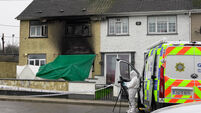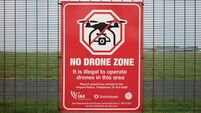Army sets its sights on €1m digital firing range at Kilworth camp

Lynch Camp in Kilworth has been targeted for significant projects and funding in recent years and the latest development, which becomes fully operational in the autumn, will make the camp as significant in terms of training troops as it was in its heyday under the British.
Up to 20 soldiers can use the firing range at a time, each equipped with a hand-held device which lets them know instantly how accurate they are.
The target will automatically fall when hit. But sensors at its base detect exactly where the bullet has landed and this information is also relayed to a control tower operator’s computers.
The range, built by Swedish company Saab, can be used day and night.
Soldiers take aim from 300 metres first and fire off 40 rounds from their standard issue Steyr Aug rifles as they dash past two further firing points nearer the target.
Snipers fire at targets from 600 metres.
It’s envisaged that obstacles may be added to the course to provide even more battlefield realism.
The range is run by camp commander Commandant Ian Harrington, regarded as a hotshot himself.
He was a Defence Forces shooting champion twice and, as former captain of its team, won a number of international awards.
The old system was slow and laborious. Previously, 20 additional soldiers had to sit in a trench and put up targets manually, then replace them and signal where the shot fell.
“We’re getting a real buy-in from the soldiers because it’s exciting and they’re getting real feedback from it. This will transform the way we do our shooting,” Cmdt Harrington said after some infantry tested it recently.
It’s another example, he said, of how the Irish Army is becoming a high-tech force.
Less than two months ago, Lynch Camp was headquarters for a major exercise by the EU-controlled Nordic Battle Group which consists of Irish, Swedish, Norwegian, Latvian and Estonian troops.
Apart from the €50m of hardware on show, troops were for the first time kitted out with iPads, 3G and 4G encrypted phones and video cameras with night-time capabilities.
By next January, they will be ready to deploy if called on by the EU and the UN.
The Kilworth camp is now headquarters to the battle group because of its excellent facilities.
It has been refurbished to accommodate 320 troops for exercises at any one time and now possesses state-of-the-art catering and fitness facilities.
Around 4,500 members of the Defence Forces will pass through Kilworth for training every year.
“We host the cadet school, infantry training school and the NCO training wing. The Naval Service and the Ranger Wing also use the facilities, which are spread over 6,000 acres and include some Coillte land we also have access to” Cmdt Harrington said.
All of the Defence Forces frontline units will visit Lynch Camp at least once a year for exercises. Those heading on overseas duties normally go there for sharpening up before heading out and the Reserve Defence Forces (former FCA) also organise summer camps there
“There’s a complete package available. We have small arms ranges, fitness training, live firing and grenade-throwing. Also on occasion we carry out training for chemical, biological, radioactive and nuclear attack,” the senior officer said.
In addition, once a year, the camp also hosts training course in bomb disposal which are attended by international groups of soldiers.
Some of these exercises have inherent risk, as Cmdt Harrington freely admits. But the camp recently acquired a 4x4 field ambulance and has medics and paramedics on standby 24/7.
Precautions are taken during firing exercises to ensure no civilians are in the danger area.
The army enjoys a very good relationship with locals and has provided work for generations of families in the area.
The local economy has benefited immensely and it’s set to benefit more in the years ahead as Lynch Camp is likely to become the Defence Forces’ busiest training centre.
A soldier training in the mist at Kilworth Camp.
In 1883, the British Army carried out large manoeuvres at Kilworth because its terrain was considered ideal for training purposes.
The British War Department purchased a substantial amount of land there a short time later and the first rifle range was opened on the site in 1886.
The British soon established a permanent camp there and removed a number of tenant farmers as they expended their training operations.
The camp came into serious use as a training post for troops heading to the Second Boer War (October 1899 — May 1902).
It became an even bigger staging post during the First World War (1914-1918).
IRA prisoners were later detained in an internment camp there during the War of Independence.
In October 1921 a number of them made a daring escape by tunnelling out under the huts and the barbed-wire fence.
The Provisional Irish Government took over the camp from the British a year later and during the Civil War it was attacked on a few occasions by Anti-Treaty forces.
During World War Two it became a training hub again for Irish troops in what became known as ‘The Emergency.’
Post-1960 Lynch Camp became synonymous for preparing troops heading out on UN peacekeeping missions. In 1966, to mark the 50th anniversary of the Easter Rising, the camp was named after General Liam Lynch.
Lynch had fought in the War of Independence and later became Chief-of-Staff of Anti-Treaty forces.
On April 10 1923 he was shot by Free State soldiers in the Knockmealdown mountains.
He is buried close to Lynch Camp at Kilcrumper Cemetery, Fermoy.
In 1969 it became a refugee camp for many Catholics who had fled rioting in the North.
In 2007 then Minister for Justice Michael McDowell announced he was taking over 150-acres of the camp to build a 400-cell super prison which would cater for offenders from the Munster region.
The plan was not welcomed by locals.
In 2012 his successor, Alan Shatter, decided to scrap the plan and instead outlined his plans to build a new prison in the car park next to the present jail in Cork City.











